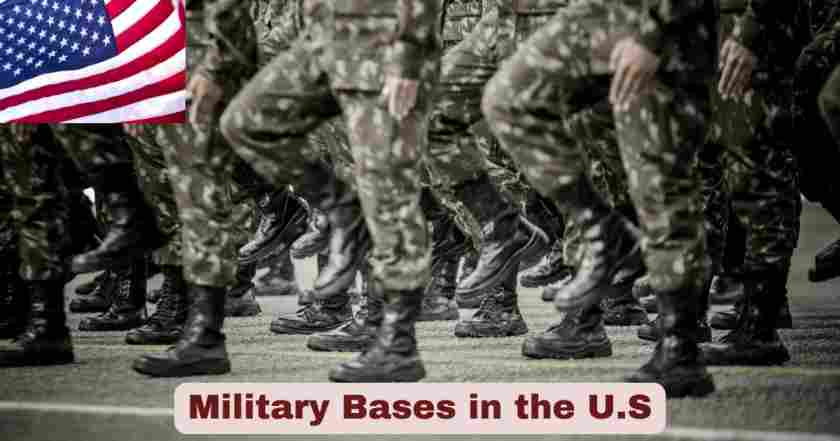Military Bases in US 2025
The United States maintains one of the world’s most extensive military infrastructure networks, with installations strategically positioned across the nation and globally. In 2025, the American military presence continues to evolve in response to changing geopolitical dynamics, technological advancements, and national security priorities. This comprehensive overview examines the current state of US military bases, providing detailed insights into their distribution, capabilities, and strategic importance.
As the backbone of American defense capabilities, military bases serve multiple critical functions including training personnel, housing equipment, conducting research and development, and projecting power worldwide. The 2025 landscape reflects decades of strategic planning, with installations ranging from massive training complexes to specialized research facilities, each contributing to the overall defense posture of the United States.
Stats & Facts About US Military Bases in 2025
| Fact Category | Details |
|---|---|
| Total Global Presence | The US maintains approximately 750 military bases in at least 80 countries worldwide |
| Domestic vs Overseas | Hundreds of installations within the US, with 128 confirmed bases in 49 foreign countries |
| Largest Overseas Base | Camp Humphreys in South Korea is the largest overseas base by area |
| Annual Maintenance Cost | Over $70 billion spent annually to maintain overseas bases |
| Personnel Distribution | 243,048 US military and civilian personnel stationed in foreign countries as of March 2025 |
| Top Foreign Locations | Japan (52,793 troops), Germany (34,547 troops), South Korea (22,844 troops) |
| Base Size Criteria | Roughly 60% of US bases have an area larger than 4 hectares or value exceeding $10 million |
| Minimum Staffing | Most significant bases are served by at least 200 US military personnel |
In 2025, the United States military maintains an extensive global infrastructure, operating around 750 military bases across at least 80 countries, making it the most geographically widespread military presence in the world. Within the U.S. borders, there are hundreds of domestic installations, while 128 confirmed military bases are stationed in 49 foreign countries, strategically placed to support global defense operations and alliances. The largest overseas military base is Camp Humphreys in South Korea, which holds the title based on land area. Supporting these installations is a massive annual investment, with the United States spending over $70 billion every year to maintain its overseas bases.
The distribution of American personnel is equally significant, with a total of 243,048 U.S. military and civilian personnel stationed outside the country as of March 2025. The highest troop concentrations are found in Japan (52,793 troops), Germany (34,547 troops), and South Korea (22,844 troops)—reflecting longstanding defense commitments in the Asia-Pacific and Europe. Around 60% of all U.S. military bases are either larger than 4 hectares or valued at more than $10 million, demonstrating the scale and infrastructure invested in these locations. Furthermore, most major bases maintain minimum staffing of at least 200 U.S. military personnel, emphasizing their operational significance and capability to support ongoing missions and rapid deployment when required.
Active Duty Personnel Stationed in US Installations 2025
| State | Active Duty Personnel | Percentage of Total |
|---|---|---|
| California | Over 100,000 | 11.5% |
| Virginia | Over 100,000 | 11.5% |
| Texas | Over 100,000 | 11.5% |
| Combined Top 3 | Over 300,000 | 34.5% |
| States with 10,000+ | 23 states + DC | Majority Coverage |
| Total Active Duty | 1.1 million | 100% |
The current military size of 1.1 million active-duty personnel represents the smallest force since pre-World War II levels, when there were only 458,365 personnel in 1940. This reduction from the Vietnam War era peak of 3.5 million active-duty members in 1968 reflects modern military efficiency and technological advancement. The concentration of personnel in key states demonstrates strategic resource allocation, with California leading due to its Pacific-facing naval installations, Virginia’s proximity to Pentagon headquarters and Atlantic operations, and Texas’s extensive training facilities and border security requirements.
Global Military Presence and Overseas Bases in the US 2025
| Country | Number of US Bases (2025) |
|---|---|
| Japan | 14 installations |
| Philippines | 9 bases |
| South Korea | 8 facilities |
| Other Countries | 97 bases across 46 nations |
| Total | 128 confirmed bases in 49 countries |
| Annual Cost | Over $70 billion |
| Regional Focus (2025) | Indo-Pacific & Middle East |
The United States maintains an unprecedented global military footprint through its extensive overseas network, comprising 128 confirmed bases in 49 countries as of 2025. This widespread presence enables the U.S. to project power, support allies, and uphold regional stability. Japan leads with 14 U.S. military installations, reflecting its strategic importance in East Asia. It is followed by the Philippines with 9 bases and South Korea with 8 facilities, all crucial in countering emerging security challenges in the Indo-Pacific. The remaining 97 bases are distributed across 46 other nations, forming a vast web of global readiness.
Maintaining this overseas network comes at a significant cost—over $70 billion annually—but it serves multiple critical functions. These include enhancing diplomatic and defense ties, enabling rapid response capabilities, and safeguarding U.S. strategic interests abroad. In 2025, the focus has intensified on Indo-Pacific installations due to shifting geopolitical dynamics, including maritime tensions and evolving alliances. Meanwhile, a substantial presence remains in the Middle East, where U.S. forces operate in more than a dozen countries, underscoring ongoing commitments to counterterrorism and regional security.
Top 10 Countries with US Military Bases and Personnel in 2025
| Rank | Country | Personnel | Primary Bases/Installations |
|---|---|---|---|
| 1 | Japan | 52,793 | Yokosuka, Okinawa, Misawa |
| 2 | Germany | 34,547 | Ramstein, Stuttgart, Grafenwoehr |
| 3 | South Korea | 22,844 | Camp Humphreys, Osan, Yongsan |
| 4 | Italy | 12,500 | Aviano, Naples, Sigonella |
| 5 | United Kingdom | 9,400 | Mildenhall, Lakenheath, Croughton |
| 6 | Bahrain | 8,900 | Naval Support Activity Bahrain |
| 7 | Saudi Arabia | 3,000 | Prince Sultan Air Base, King Abdulaziz Air Base |
| 8 | Turkey | 2,400 | Incirlik Air Base |
| 9 | Kuwait | 2,300 | Camp Arifjan, Ali Al Salem |
| 10 | Qatar | 2,200 | Al Udeid Air Base |
The top 10 countries hosting US military bases represent strategic partnerships and security commitments spanning multiple continents. Japan leads with 52,793 personnel, primarily stationed at major installations including Yokosuka Naval Base, multiple facilities in Okinawa, and Misawa Air Base. This substantial presence reflects the critical US-Japan alliance and regional security requirements in the Indo-Pacific theater.
Germany maintains the second-largest US military presence with 34,547 personnel, concentrated at key installations like Ramstein Air Base, Stuttgart headquarters, and Grafenwoehr Training Area. The European presence demonstrates America’s commitment to NATO alliance obligations and transatlantic security partnerships. South Korea rounds out the top three with 22,844 troops, primarily at Camp Humphreys (the largest overseas US base), Osan Air Base, and the transitioning Yongsan Garrison. Saudi Arabia holds the 7th position with 3,000 personnel, stationed primarily at Prince Sultan Air Base and King Abdulaziz Air Base, reflecting ongoing Middle Eastern security commitments and regional defense partnerships.
Regional Military Presence and Troop Distribution in the US 2025
| Region | Countries | Personnel | Primary Mission |
|---|---|---|---|
| Asia-Pacific | Japan, South Korea, Philippines | Over 75,000 | Regional Security |
| Europe | Germany, Italy, UK | Over 50,000 | NATO Alliance |
| Middle East | 12+ countries | 40,000-50,000 | Counterterrorism |
| Total Overseas | 49 countries | 243,048 | Global Security |
The regional distribution demonstrates America’s commitment to maintaining global stability through forward-deployed forces. The Asia-Pacific region remains the largest overseas commitment, with Japan hosting 52,793 troops, reflecting the importance of the US-Japan alliance and regional deterrence strategies. European deployments in Germany (34,547 troops) and other NATO countries underscore transatlantic security partnerships developed over decades.
The Middle East presence of 40,000-50,000 troops across at least 19 sites represents ongoing counterterrorism efforts and regional security commitments. This presence expanded in 2024 as the United States focused on deterring threats from Iran and its network of regional affiliates, demonstrating the dynamic nature of military deployment strategies.
Infrastructure and Facility Management in US Military Bases 2025
| Infrastructure Category | Details |
|---|---|
| Total Installations | Hundreds of domestic installations |
| Excess Capacity | Identified in certain facility types |
| Modernization Status | Ongoing infrastructure updates |
| Data Source | Office of Assistant Secretary of Defense |
| Last Updated | October 23, 2024 |
| Fiscal Year | 2023 data basis |
Military infrastructure management in 2025 reflects ongoing efforts to modernize and optimize facilities while addressing excess capacity issues. The Department of Defense continues to evaluate infrastructure needs, with services developing comprehensive plans to address capacity imbalances identified in the January 2025 Congressional report.
Infrastructure modernization efforts focus on incorporating advanced technologies, improving energy efficiency, and enhancing security measures. The Bureau of Transportation Statistics maintains detailed geodata about military installations, providing essential information for planning and logistics operations. These facilities must adapt to evolving mission requirements while maintaining operational readiness across diverse geographic and climatic conditions.
Strategic Importance and Future Outlook of US Military Bases 2025
The strategic importance of US military bases in 2025 extends far beyond traditional defense roles, encompassing diplomatic influence, economic impact, and technological advancement. These installations serve as platforms for international cooperation, humanitarian assistance, and disaster response capabilities while maintaining deterrence against potential threats.
Looking ahead, military base operations will increasingly integrate emerging technologies including artificial intelligence, cyber warfare capabilities, and space-based assets. The $70 billion annual investment in overseas installations alone demonstrates the significant commitment to maintaining global presence, while domestic bases continue evolving to meet 21st-century security challenges. The strategic distribution of forces reflects careful balance between global commitments and homeland defense requirements, ensuring American military capabilities remain adaptable to emerging threats and opportunities in an increasingly complex security environment.
Disclaimer: The data research report we present here is based on information found from various sources. We are not liable for any financial loss, errors, or damages of any kind that may result from the use of the information herein. We acknowledge that though we try to report accurately, we cannot verify the absolute facts of everything that has been represented.







